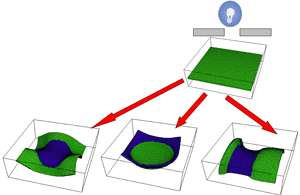A team of scientists, part of a collaborative effort involving multiple Universities from the U.S., are proposing to take 3D printing one step further by adding a new dimension – time. Their work involves building a new class of materials that can morph, change their physical properties and functionality over time based on external stimuli by exploiting the high precision capabilities of 3-D printing.

Imagine an automobile coating that changes its structure to adapt to a humid environment or a salt-covered road, better protecting the car from corrosion. Or consider a soldier’s uniform that could alter its camouflage or more effectively protect against poison gas or shrapnel upon contact. The latter example is actually of great importance since the research was recently awarded a $855,000 grant from the United States Army Research Office.
The team includes principal investigator Anna C. Balazs, the Robert v. d. Luft Distinguished Professor of Chemical Engineering in Pitt’s Swanson School of Engineering and a researcher in the computational design of chemo-mechanically responsive gels and composites. Co-investigators are Jennifer A. Lewis, the Hansjo?rg Wyss Professor of Biologically Inspired Engineering at the Harvard School of Engineering and Applied Sciences and an expert in 3D printing of functional materials; and Ralph G. Nuzzo, the G. L. Clark Professor of Chemistry and Professor of Materials Science and Engineering at the University of Illinois, a synthetic chemist who has created novel stimuli-responsive materials.
4D materials
“Rather than construct a static material or one that simply changes its shape, we’re proposing the development of adaptive, biomimetic composites that reprogram their shape, properties, or functionality on demand, based upon external stimuli,” Balazs explained. “By integrating our abilities to print precise, three-dimensional, hierarchically-structured materials; synthesize stimuli-responsive components; and predict the temporal behavior of the system, we expect to build the foundation for the new field of 4D printing.”
The trio of researchers will combine their high-end expertise to manipulate materials at the micro and nano scale using 3-D printing to layer their 4D composites. If you’re not familiar with the tech yet, basically 3D printing involves precision nanoscale depositing of materials, layer by layer, thus crafting high fidelity 3D objects based on a digital model. Since they’re very precise, 3D printers will allow the scientists to build their intricate nano-patterns in specific areas of the structure.
“If you use materials that possess the ability to change their properties or shape multiple times, you don’t have to build for a specific, one-time use,” she explained. “Composites that can be reconfigured in the presence of different stimuli could dramatically extend the reach of 3D printing.”
Since the research will use responsive fillers embedded within a stimuli-responsive hydrogel, Nuzzo says this opens new routes for producing the next generation of smart sensors, coatings, textiles, and structural components.
“The ability to create one fabric that responds to light by changing its color, and to temperature by altering its permeability, and even to an external force by hardening its structure, becomes possible through the creation of responsive materials that are simultaneously adaptive, flexible, lightweight, and strong. It’s this ‘complicated functionality’ that makes true 4D printing a game changer.”
Was this helpful?



